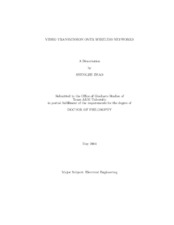| dc.description.abstract | Compressed video bitstream transmissions over wireless networks are addressed in this work. We first consider error control and power allocation for transmitting wireless video over CDMA networks in conjunction with multiuser detection. We map a layered video bitstream to several CDMA fading channels and inject multiple source/parity layers into each of these channels at the transmitter. We formulate a combined optimization problem and give the optimal joint rate and power allocation for each of linear minimum mean-square error (MMSE) multiuser detector in the uplink and two types of blind linear MMSE detectors, i.e., the direct-matrix-inversion (DMI) blind detector and the subspace blind detector, in the downlink. We then present a multiple-channel video transmission scheme in wireless CDMA networks over multipath fading channels. For a given budget on the available bandwidth and total transmit power, the transmitter determines the optimal power allocations and the optimal transmission rates among multiple CDMA channels, as well as the optimal product channel code rate allocation. We also make use of results on the large-system CDMA performance for various multiuser receivers in multipath fading channels. We employ a fast joint source-channel coding algorithm to obtain the optimal product channel code structure. Finally, we propose an end-to-end architecture for multi-layer progressive video delivery over space-time differentially coded orthogonal frequency division multiplexing (STDC-OFDM) systems. We propose to use progressive joint source-channel coding to generate operational transmission distortion-power-rate (TD-PR) surfaces. By extending the rate-distortion function in source coding to the TD-PR surface in joint source-channel coding, our work can use the ??equal slope?? argument to effectively solve the transmission rate allocation problem as well as the transmission power allocation problem for multi-layer video transmission. It is demonstrated through simulations that as the wireless channel conditions change, these proposed schemes can scale the video streams and transport the scaled video streams to receivers with a smooth change of perceptual quality. | en |


